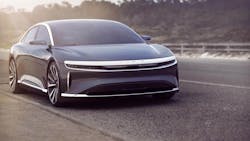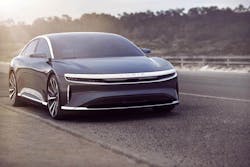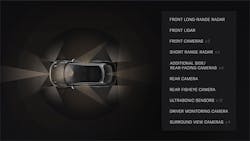Lucid Motors EV Claims Estimated EPA Range of 517 Miles
“Range anxiety” is often defined as the fear that an electric vehicle may run out of power before reaching its destination, thus stranding the vehicle's occupants. It’s considered the primary barrier to widespread EV adoption.
Lucid Motors, which thinks it has the cure to the range anxiety affliction, announced an independent range verification of 517 miles on a single charge for its forthcoming Lucid Air all-electric sedan. This new benchmark range was obtained with FEV North America, based in Auburn Hills, Mich., a company that specializes in testing and development of various automotive systems. In its testing, FEV applied the Environmental Protection Agency's (EPA) Multicycle Test Procedure (SAE J1634 Oct 2012 Standard). Lucid expects that the official EPA range should be similar or maybe even slightly higher.
The results make the Lucid Air model the longest-range electric vehicle to date, according to Peter Rawlinson, CEO and CTO of Lucid Motors. By comparison, the Tesla Model S Long Range can travel a certified distance of 402 miles on a single charge.
Rawlinson is particularly proud that the technology behind Lucid Air was all developed in-house, not bought off the shelf (Tesla also does it all in-house). Said Rowlinson, “I believe that our 900-V architecture, our race proven battery packs, miniaturized motors and power electronics, integrated transmission systems, aerodynamics, chassis and thermal systems, software, and overall system efficiency has now reached a stage where it collectively sets a new standard and delivers a host of ‘world’s firsts.’”
900-V Architecture
The Lucid Air employs a 900-V system that’s said to lessen losses to heat. According to the company, the car generates just a fifth of the heat losses it was making three years ago. With fewer heat losses, the openings on the body for cooling are also reduced, which helps contribute to the Air’s 0.21 coefficient of drag. The company has also linked the 900-V system with the inverter, which controls the motor drivers. It’s a silicon-carbide MOSFET-type inverter, replacing the old insulated-gate bipolar transistor (IGBT) version. The 2017 developmental model was at 400 V with IGBTs.
In creating the Air’s battery packs, Lucid drew upon 10 years of experience and over 20 million miles of real-world testing. In addition, the expertise of Lucid’s technology division, Atieva, played a large role, gaining experience from supplying battery packs for the entire field of Formula E racing cars since 2018 and continuing through 2022. Software for the race car’s battery management system (BMS) was also created entirely in-house and ensures that the pack “performs for the duration of the racing season with no significant degradation.”
The Lucid Air uses a battery pack that’s “less than 130 kWh.” Lucid noted that 130 kWh was the battery size the company thought it would need to make the 400 miles of range back in 2017. The firm has a long-term partnership with EV battery supplier LG Chem for its pure-electric sedan. LG Chem battery cells will exclusively power standard versions of the luxury EV through 2023.
Aero Efficiency
Aerodynamic efficiency plays a key role in achieving EV range and performance. “Key to our development process was creating Lucid’s own aerodynamic design philosophy for electric vehicles honed from years of success in Formula One,” said Jean-Charles Monnet, Lead Aerodynamicist, Lucid Motors. “We applied lessons learned from shaping the world’s highest-performance racing machines as integral to the Lucid Air’s design process. It’s not just about achieving the lowest coefficient of drag; it’s also key to have a highly balanced performance vehicle with precisely managed airflow in all aspects.”
With tests recently completed at Windshear’s advanced rolling-road wind tunnel in Concord, N.C., Lucid verified a coefficient of drag of 0.21, making the Lucid Air the world’s most aero-efficient luxury car. Windshear’s wind tunnel facility is a closed-air circuit, temperature-controlled system built around a rolling road that accommodates full-size vehicles, with air and rolling road speeds coordinated up to 180 mph. Air is moved through at a maximum rate of 47,500 cu. ft. per second by a 5,100-hp motor and 29 carbon fiber blades that are 22 feet in diameter.
Lucid Air has functional surfaces that work to guide air efficiently through and around the car. This includes side air intakes in the front fascia that smooth airflow around the typically turbulent wheel wells, aerodynamically optimized wheel designs, and vents in the hood that channel air around the flanks of the car.
Beneath the skin, the Lucid Air features a proprietary and patented vortex-generating air intake system behind the front bumper. This system maximizes cooling performance by uniformly distributing air on heat-exchange surfaces while minimizing the size of the air intake aperture, further increasing aero efficiency.
Underneath the Lucid Air, the undersurface curves progressively upward toward the rear to form an aerodynamic diffuser. The effectiveness of this diffuser has been enhanced by virtue of the battery pack itself providing part of its curved “V” form.
DreamDrive
Standard on the first versions of the Lucid Air will be the company’s DreamDrive advanced driver-assistance systems (ADAS). “We have developed Lucid DreamDrive to be among the most advanced ADAS to ever be offered to consumers,” said Dr. Eugene Lee, Senior Director, ADAS and Autonomous Driving, Lucid Motors. “By prioritizing safety and updatability, Lucid DreamDrive also sets the stage for offering increasingly sophisticated driver-assistance features. We have ensured that the Lucid DreamDrive hardware and software platform not only offers a full suite of (SAE) Level 2 features, but is also Level 3 ready, which means we’ll be able to quickly add features and functions over-the-air throughout the lifetime of Lucid Air and for future Lucid models.”
Lucid Air will come to market with 32 sensors comprising camera, radar, and ultrasonic sensors, as well as a long-range, high-resolution LiDAR placed at the front of the car. Also included in this multimodal sensor suite is an in-car driver-monitoring system designed to share relevant information with the driver while ensuring their necessary attention to the driving configuration. As with the vehicle’s other software systems, upgrades will be delivered over-the-air throughout the lifetime of the car, including new ADAS functionality and service offerings.
Lucid further said its DreamDrive will “leverage HD mapping and a first-of-its-kind Ethernet Ring” as part of its electric architecture to ensure full redundancy on key functions, with over-the-air updates on all systems including ADAS.
Featuring a mid-size exterior footprint, the Lucid Air will be capable of accelerating from 0 to 60 mph in under 2.5 seconds.
The production version of the Lucid Air will debut in an online reveal on September 9, 2020. At that time, in addition to the vehicle’s final interior and exterior designs, new details about production specifications, available configurations, and pricing information will also be shared. Customer deliveries of the Lucid Air, which will be produced at Lucid’s new factory in Casa Grande, Ariz., will begin in early 2021.


